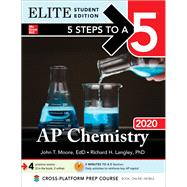Preface
Acknowledgments
About the Authors
Introduction: The Five-Step Program
Step 1 Set Up Your Study Program
1 What You Need to Know About the AP Chemistry Exam
Background of the Advanced Placement Program
Who Writes the AP Chemistry Exam?
The AP Grades and Who Receives Them
Reasons for Taking the AP Chemistry Exam
Questions Frequently Asked About the AP Chemistry Exam
2 How to Plan Your Time
Three Approaches to Preparing for the AP Chemistry Exam
Calendar for Each Plan
Step 2 Determine Your Test Readiness
3 Take a Diagnostic Exam
Getting Started: The Diagnostic Exam
Answers and Explanations
Scoring and Interpretation
Step 3 Develop Strategies for Success
4 How to Approach Each Question Type
Multiple-Choice Questions
Free-Response Questions
Step 4 Review the Knowledge You Need to Score High
5 Basics
Units and Measurements
Dimensional Analysis—the Factor Label Method
The States of Matter
The Structure of the Atom
Periodic Table
Oxidation Numbers
Nomenclature Overview
Experiments
Common Mistakes to Avoid
Review Questions
Answers and Explanations
Free-Response Question
Answer and Explanation
Rapid Review
6 Reactions and Periodicity
AP Exam Format
General Aspects of Chemical Reactions and Equations
General Properties of Aqueous Solutions
Precipitation Reactions
Oxidation–Reduction Reactions
Coordination Compounds
Acid–Base Reactions
Experiments
Common Mistakes to Avoid
Review Questions
Answers and Explanations
Free-Response Question
Answer and Explanation
Rapid Review
7 Stoichiometry
Moles and Molar Mass
Percent Composition and Empirical Formulas
Reaction Stoichiometry
Limiting Reactants
Percent Yield
Molarity and Solution Calculations
Experiments
Common Mistakes to Avoid
Review Questions
Answers and Explanations
Free-Response Question
Answer and Explanation
Rapid Review
8 Gases
Kinetic Molecular Theory
Gas Law Relationships
Experiments
Common Mistakes to Avoid
Review Questions
Answers and Explanations
Free-Response Question
Answer and Explanation
Rapid Review
9 Thermodynamics
Calorimetry
Laws of Thermodynamics
Products Minus Reactants
Thermodynamics and Equilibrium
Experiments
Common Mistakes to Avoid
Review Questions
Answers and Explanations
Free-Response Question
Answer and Explanation
Rapid Review
10 Spectroscopy, Light, and Electrons
The Nature of Light
Wave Properties of Matter
Atomic Spectra
Atomic Orbitals
Photoelectron (Photoemission) Spectroscopy (PES)
Experiments
Common Mistakes to Avoid
Review Questions
Answers and Explanations
Free-Response Question
Answer and Explanation
Rapid Review
11 Bonding
Lewis Electron-Dot Structures
Ionic and Covalent Bonding
Molecular Geometry—VSEPR
Valence Bond Theory
Molecular Orbital Theory
Resonance
Bond Length, Strength, and Magnetic Properties
Experiments
Common Mistakes to Avoid
Review Questions
Answers and Explanations
Free-Response Question
Answer and Explanation
Rapid Review
12 Solids, Liquids, and Intermolecular Forces
Structures and Intermolecular Forces
The Liquid State
The Solid State
Phase Diagrams
Relationship of Intermolecular Forces to Phase Changes
Experiments
Common Mistakes to Avoid
Review Questions
Answers and Explanations
Free-Response Question
Answer and Explanation
Rapid Review
13 Solutions and Colligative Properties
Concentration Units
Electrolytes and Nonelectrolytes
Colligative Properties
Colloids
Experiments
Common Mistakes to Avoid
Review Questions
Answers and Explanations
Free-Response Questions
Answers and Explanations
Rapid Review
14 Kinetics
Rates of Reaction
Integrated Rate Laws
Activation Energy
Reaction Mechanisms
Catalysts
Experiments
Common Mistakes to Avoid
Review Questions
Answers and Explanations
Free-Response Question
Answer and Explanation
Rapid Review
15 Equilibrium
Equilibrium Expressions
Le Châtelier’s Principle
Acid–Base Equilibrium
Buffers
Titration Equilibria
Solubility Equilibria
Other Equilibria
Experiments
Common Mistakes to Avoid
Review Questions
Answers and Explanations
Free-Response Question
Answer and Explanation
Rapid Review
16 Electrochemistry
Redox Reactions
Electrochemical Cells
Quantitative Aspects of Electrochemistry
Nernst Equation
Experiments
Common Mistakes to Avoid
Review Questions
Answers and Explanations
Free-Response Question
Answer and Explanation
Rapid Review
17 Nuclear Chemistry
Nuclear Reactions
Nuclear Stability
Nuclear Decay Calculations
Mass–Energy Relationships
Common Mistakes to Avoid
Review Questions
Answers and Explanations
Free-Response Question
Answer and Explanation
Rapid Review
18 Organic Chemistry
Alkanes
Structural Isomerism
Common Functional Groups
Macromolecules
Experiments
Common Mistakes to Avoid
Review Questions
Answers and Explanations
Free-Response Questions
Answers and Explanations
Rapid Review
19 Experimental Investigations
Experiment 1: Spectroscopy
Experiment 2: Spectrophotometry
Experiment 3: Gravimetric Analysis
Experiment 4: Titration
Experiment 5: Chromatography
Experiment 6: Determination of the Type of Bonding in Solid Samples
Experiment 7: Stoichiometry
Experiment 8: Redox Titration
Experiment 9: Chemical and Physical Changes
Experiment 10: Kinetics
Experiment 11: Rate Laws
Experiment 12: Calorimetry
Experiment 13: Chemical Equilibrium—Le Châtelier’s Principle
Experiment 14: Acid–Base Titrations
Experiment 15: Buffer pH
Experiment 16: The Capacity of a Buffer
Common Mistakes to Avoid
Review Questions
Answers and Explanations
Free-Response Question
Answer and Explanation
Rapid Review
Step 5 Build Your Test-Taking Confidence
AP Chemistry Practice Exam 1
AP Chemistry Practice Exam 1, Section I (Multiple Choice)
Answers and Explanations for Exam 1, Section 1 (Multiple Choice)
AP Chemistry Practice Exam 1, Section II (Free Response)
Answers and Explanations for Exam 1, Section II (Free Response)
AP Chemistry Practice Exam 2
AP Chemistry Practice Exam 2, Section I (Multiple Choice)
Answers and Explanations for Exam 2, Section 1 (Multiple Choice)
AP Chemistry Practice Exam 2, Section II (Free Response)
Answers and Explanations for Exam 2, Section II (Free Response)
Elite Student Edition 5 Minutes to a 5 180 Activities and Questions in 5 Minutes a Day
Appendixes
SI Units
Balancing Redox Equations Using the Ion-Electron Method
Common Ions
Bibliography
Websites
Glossary
Avoiding “Stupid” Mistakes on the Free-Response Section
Exam Resources








